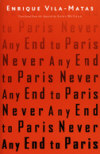Never Any End to Paris
Spanish novelist Enrique Vila-Matas takes his title Never Any End to Paris from Hemingway’s A Moveable Feast. But whereas Hemingway was poor but happy in Paris, the narrator says of his two years as a young man in the 1970s, “I went to Paris and was very poor and very unhappy.” Although the narrator (a stand-in for the author) uses his early life in a Paris garret to give a three-day lecture, for the most part this novel feels more like a fictionalized memoir than a lecture. The narrative shows the intellectual life of the times with famous and not so famous writers and eccentrics. It also reviews approaches to writing, since the narrator asks advice while writing his first novel. And irony figures in this account with Vila-Matas’ erudite wit and keen eye for absurdity or the ridiculous. It even appears with the narrator’s not understanding irony: “irony is the highest form of sincerity.”
Spanish novelist Enrique Vila-Matas takes his title Never Any End to Paris from Hemingway’s A Moveable Feast. But whereas Hemingway was poor but happy in Paris, the narrator says of his two years as a young man in the 1970s, “I went to Paris and was very poor and very unhappy.” Although the narrator (a stand-in for the author) uses his early life in a Paris garret to give a three-day lecture, for the most part this novel feels more like a fictionalized memoir than a lecture. The narrative shows the intellectual life of the times with famous and not so famous writers and eccentrics. It also reviews approaches to writing, since the narrator asks advice while writing his first novel. And irony figures in this account with Vila-Matas’ erudite wit and keen eye for absurdity or the ridiculous. It even appears with the narrator’s not understanding irony: “irony is the highest form of sincerity.”
In the beginning there’s a sense of a lecture. But even there he asks of his listeners, “Am I a lecture or a novel?” The sense of a lecture ends with his collecting his audience’s interpretations of Hemingway’s story “Cat in the Rain.” Though he indicates the end of each of the three lectures, they don’t sound like lectures.
The chronology loosely evolves from the opening, when he tries and fails to look like his favorite author, Ernest Hemingway, in a Key West, Florida contest. However, most of the novel is set in Paris, where he discovers a plot and title for his first novel from Unamuno’s The Lettered Assassin, a novel which kills off its readers. Afterwards, his famous landlady Marguerite Duras gives him a list of terms like plot and structure, which reappear later in his progression as a writer.
Throughout the book he tells stories about writers and famous people. The trip F. Scott Fitzgerald and the then lesser-known writer Hemingway took together marks the beginning of their troubled relationship and also is reminiscent of the “Cat in the Rain” story. The narrator sees George Orwell’s wife sweeping the staircase of his apartment building, and later yet he spots Samuel Beckett fiercely reading a newspaper in a dreary park. Most of the luminaries provide elements for his novel, for instance, a place name from a Maria Rilke poem, and his assassin’s eyes from an angry actress, Isabella Adjani.
The narrator accepts and rejects theories about writing from various writers: Stendahl’s “writing on the spot,” emotion and thought being inseparable, Rimbaud’s reinventing life with the past and future having no meaning, the surprises that happen during the writing, life and art like comedy and tragedy merging, the need to throw away passages the writer likes (fitting Duras’ dictum about plot and consistency), the book evolving like conversation, “doubt” as “writing,” the value of experience and dialogue. And Hemingway warns with his iceberg analogy, “Never tell what is most important.”
The narrator asks himself:
If I were really a writer, I said to myself, I wouldn’t have such atrocious problems. But would I have to wait until I am older to have them? Did one ever get to be a real writer?
If I were really a writer, I said to myself, Africa would be Mine. And why Africa? Because I’d know the melancholy of returning to where I’d never been.
If I were really a writer, I’d try like Rimbaud to create all the celebrations, all the triumphs, all the dramas…
If I were really a writer, I would be absolutely modern…If I were really a writer, my days would go by in a very different way. If I were really a writer…
And so absurdity reigns. How can the novelist have readers if his novel kills them off? But in killing the readers, a writer begins his writing life. “I quoted a man who was famous (Borges), and I was a man who was no one.” His own novel he thought original until he read an Agatha Christie novel which ends the same way. At a bar while reading his Spanish newspapers, he is mistaken for Carlos, the Spanish killer. The policemen read his book The Lettered Assassin, “thinking my as yet unfinished book might be a collection of secret documents on international terrorism.” Finally, the only thing he learned in his two years in Paris was how to type.
His daily encounters with often lesser-known writers and acquaintances sometimes make this novel seem long, but they bring to life the 1970s literati’s life in Paris. Readers with a wry sense of humor, and those interested in writers and writing, will relish this very readable novel.





